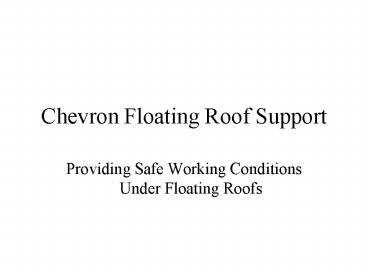Chevron Floating Roof Support - PowerPoint PPT Presentation
1 / 8
Title:
Chevron Floating Roof Support
Description:
The Euler buckling mode of a floating roof leg determines its strength. ... Local buckling or collapse of legs can be sustained by most floating roofs if ... – PowerPoint PPT presentation
Number of Views:182
Avg rating:3.0/5.0
Title: Chevron Floating Roof Support
1
Chevron Floating Roof Support
- Providing Safe Working Conditions Under Floating
Roofs
2
Types of Roof Collapse
- Roof Spiral
- this will result in the entire roof coming down
- the strength and condition of the legs have no
effect on this type of collapse - this is the most dangerous collapse mode
- Vertical Collapse
- will not result in complete roof collapse unless
this initiates spiral mode above - typically will result in excessive distortion in
a local area not complete collapse to the tank
bottom
3
Sources Of Complete Roof Collapse
- Roof Spiral
- Roof anti-rotation device may not exist or may
fail. - Lateral support provided by a modern rim seal is
adequate to resist lateral movement. If the seal
is removed without adding temporary lateral
restraint, the roof can move laterally. The
lateral movement alone is not usually enough to
cause problems beyond local leg failures.
However, it may initial rotational movement which
is almost always the source of complete roof
collapse.
4
Sources of Local Leg Failures
- Vertical Collapse
- The flexibility of most floating roofs allow them
to withstand local leg failures without total
collapse of the roof. - Landing floating roofs which are holding water or
product on the deck is the most common source of
leg failure. - A properly landed roof with corroded or damaged
legs is also susceptible to collapse.
5
Prevention of Roof Spiraling
- Prevent Rotational Movement
- The Euler buckling mode of a floating roof leg
determines its strength. Without restraint to
movement at the deck, the allowable load of the
leg is greatly decreased regardless of its
condition or size. - The forces required to prevent rotation are not
excessive. Once the roof begins to rotate the
loading on back up systems are much harder to
quantify and design for. Properly engineered
systems can insure the spiral mode is avoided. - Prevent Lateral Movement
- Lateral movement can be easily controlled by
blocking the rim. This limits potential movement
of the roof to maintain stability.
6
Prevention of Vertical Roof Collapse
- Be sure roof is not landed with water or product
on the deck. - Open the deck emergency drain to insure the
landed roof does not accumulate water. - Inspect corrosion of legs and leg sleeves.
- Inspect plumness and alignment of legs.
7
Industry Standard Roof Support
- Insure rotational and lateral roof support.
- Unloaded roofs will not completely collapse when
properly restrained against rotation or lateral
movement. - The restraint must be in good working order. If
this cannot be verified, backup anti-rotation
shall be used. - Rim seals which are removed shall be replaced by
rim blocks or other lateral restraints. - Inspect the condition of each leg.
- Test leg thickness. UT or use a hammer test.
- Verify plumbness and proper landing of legs.
Insure legs are not under designed. - Prevent loads from developing on the roof deck.
- Provide temporary support to questionable legs.
8
Summary
- Floating roof supports are designed very similar
to fixed roof columns. Fixed roof collapse is
virtually non-existent because the fixed roofs
attachment to the shell limits any movement at
the top of the columns. If floating roofs are
similarly restrained against this movement they
will be highly reliable. - Local buckling or collapse of legs can be
sustained by most floating roofs if
anti-rotations and lateral support is present.
Legs which are susceptible to local collapse can
easily be identified for corrective action.
Landed roofs should never be holding water or
product on the deck. - Back up systems should directly address the
sources of collapse. Systems which are designed
to support the roof after a failure mode is
initiated are difficult to design as the loading
during this failure cannot be easily predicted.































